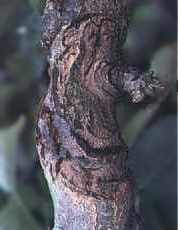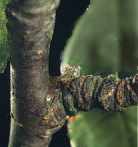Categories
Calendars
Guides
Reviews
Archive
Gallery
Articles
Ask Our Gardening Expert
Identify and Cure Canker
CANKER Fungal Canker The canker is first noticeable in autumn as a swelling of the bark -
often at the site of a pruning wound or damaged bud. The central
part of the swelling begins to die back and the bark flakes off
leaving a sunken discoloured area. In summer, white fungus grows on the diseased bark,
turning to a red fungus like growth in winter.
Bacterial Canker How to Treat Canker GO
TO THE GARDEN PEST AND DISEASE MAIN PAGE FOR
There are two common forms of canker, fungal canker
and bacterial canker.
 Commonly
found in the UK on apple and pear trees, but also affects other
trees including ash, beech,
hawthorn, poplar, sorbus and willow. Unfortunately this disease
also affects the world's best loved plant, the rose.
Commonly
found in the UK on apple and pear trees, but also affects other
trees including ash, beech,
hawthorn, poplar, sorbus and willow. Unfortunately this disease
also affects the world's best loved plant, the rose.
 A
serious tree disease in the UK for almonds, cherries,
nectarines, peaches and plums. First symptoms in autumn are
shallow depressions at the base of branches which enlarge in
spring, completely circling the base of the branch and causing
it to die. An amber like gum may also appear.
A
serious tree disease in the UK for almonds, cherries,
nectarines, peaches and plums. First symptoms in autumn are
shallow depressions at the base of branches which enlarge in
spring, completely circling the base of the branch and causing
it to die. An amber like gum may also appear.
Diseased patches should be cut out, back to good wood, using a
knife or chisel - burn the diseased wood. The exposed
healthy wood can be painted with a canker paint available from
larger garden centres. If canker is a major problem, spraying
with a copper based fungicide (bordeaux mixture is sold by most
garden centres), in August, September and October will greatly
assist. Three consecutive sprayings are needed for the full effect.
PESTS AND DISEASES CLASSIFIED BY PLANT